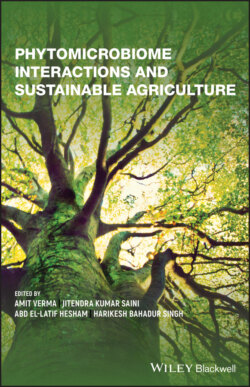Читать книгу Phytomicrobiome Interactions and Sustainable Agriculture - Группа авторов - Страница 31
3.1 Introduction
ОглавлениеLike the human body, microbes also colonize inside plants (Qin et al. 2010; Zhao 2010; Gevers et al. 2012). The collective colonization of plant‐associated microbiota is known as a plant microbiome, which is a key determinant governing plant health and its productivity (Berendsen et al. 2012).
Recent years have seen a remarkable interest in such interactions (Lebeis et al. 2012; Turner et al. 2013). A plant’s internal microbiome, also referred to as endophytic microbes, includes members from almost all microbial communities, such as archaea, bacteria, and fungi (Turner et al. 2013; Hardoim et al. 2015). Sometimes these microbial communities colonize inside plants in such a manner that their number surpasses the number of plant's own cells (Mendes et al. 2013). It is interesting to note that soil microbiomes are now touted as a cornerstone of the next green revolution (Parnell et al. 2016). The concept of soil, microbes, and plant interface, i.e. “soil‐microbe‐plant interface” is not new. However, the “soil‐microbe–soil‐plant–microbe‐plant interface” represents plant microbiome interaction more adequately. The rhizosphere that is affected by several climatic factors influences the plant and microbiome which ultimately utilize the habitat as an information highway (Bais et al. 2004; Roume et al. 2015; Tomer et al. 2017).
A selection effect that is imposed due to the physicochemical changes surrounding roots shapes the microbial composition inside a plant host. One way to this selection is favoring the growth of such opportunistic microbes that are adapted to specific chemical conditions, which is an indirect approach. Alternatively, the microbes that support the growth/development of plants and/or enhance their survival in stress conditions are directly recruited (Bulgarelli et al. 2013; Philippot et al. 2013; Mendes et al. 2014; Suyal et al. 2014). Another habitat where the microbiome interacts with the plant is the rhizoplane, a surface of plant tissues that comes into contact with the soil. Apart from endophytes located inside plant tissues, “epiphytes” is a class of the plant microbiome, which can be found in an adherent form on plant tissues (Bulgarelli et al. 2013). Several studies have explored the structure and function of the microbiome of both model and crop plant species under natural and agricultural environments (Bulgarelli et al. 2012; Rascovan et al. 2016; Hamonts et al. 2018; Kumar et al. 2018a,b). To explore more diversity of plant microbiomes, there is a need to integrate novel molecular technologies, e.g. metagenomics and metatranscriptomics (van der Heijden and Hartmann 2016).
